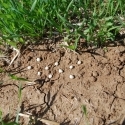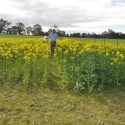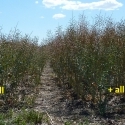11 Mar 2015
High rainfall zone nutrient omission trials 2015
Part of the GRDC project DAV00141 led by P Riffkin
 Glenthompson HRZ omission experiment
Glenthompson HRZ omission experiment
During 2015 four sites were selected - two in Victoria and two in South Australia, to investigate the potential limitation that nutrition may have on achieving wehat and canola yield potentials in that region.
The sites were located at Inverleigh (canola), Glenthompson (wheat), Frances (canola) and Bool Lagoon (wheat). At each of these sites, a common experimental design was used, based on the omission of nutrients one at a time from a full nutrient supply. Nutrient omission experiments aim to test crop yield response and the interactions among nutrients where P, K and S are omitted, so the design has a complete set of nutrients along with a no nutrient control. The target rates of nutrients were relatively high so that the supplied nutrient is not limiting. In addition, at each site, it was aimed to provide three levels of N to raise yield potentials where nutrients were supplied, and the N rates were based on yield potentials as the season developed at the end of vegetative development and during mid-stem elongation. The rates applied differed from site to site depending on starting mineral N and estimated mineralization. An additional treatment of the full nutrient with no N applied was also included.
The rates of nutrient used were 25 kg P/ha, 50 kg K/ha, 20 kg S/ha, Zn/Cu (1+2 kg/ha). Fertilizer blends were developed using monoammonium phosphate (MAP), mutriate of potash (MOP, sulphate of potash (SOP), ammonium sulfate (AmS), urea and zinc and copper in the sulfate form. The design is shown diagramatically in the image below:









